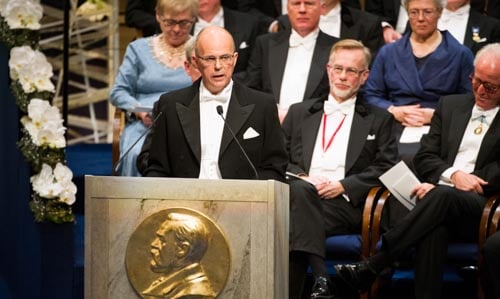Award ceremony speech

Professor Per Krusell delivering the Presentation Speech for the Sveriges Riksbank Prize in Economic Sciences in Memory of Alfred Nobel 2013 at the Stockholm Concert Hall.
Copyright © Nobel Media AB 2013
Photo: Alex Ljungdahl
English
Swedish
Presentation Speech by Professor Per Krusell, Member of the Royal Swedish Academy of Sciences, Chairman of the Economics Sciences Prize Committee, 10 December 2013.
Your Majesties, Your Royal Highnesses, Dear Laureates, Ladies and Gentlemen,
The prices of shares and other assets fluctuate a great deal from time to time. Take Swedish shares as an example. Today, the total value of the Stockholm stock market is about 15 times the companies’ current profits. But five years ago, in 2008, the same market was valued at eight times profits, and in 2000 it was 30 times profits. What is the origin of these swings? Do share prices really reflect the true underlying ability of companies to generate profits? Or do they rather represent an irrational and sentiment-driven market that oscillates between unfounded optimism and unfounded pessimism?
These questions are of great relevance because asset prices guide central economic decisions. Household savings are turned into productive investments through financial markets, so share prices ought to signal which investments are the most productive ones. Prices should also correctly reflect differences in risks, in such a way that high-risk investments are compensated by higher average returns. Mispricing can imply significant costs for society as a whole.
In their research, Eugene Fama, Lars Peter Hansen and Robert Shiller have helped us better understand how asset prices are determined. The challenge here is to find an appropriate yardstick. To identify the “correct” asset price, we must correctly compute and discount the revenues this asset generates in the future. But without access to a crystal ball, how can we look into the future? And what weights should we place on future revenues?
In order to approach the difficult question of correct pricing, start with a simpler one: are prices predictable? In a well-functioning market, it should not be possible to foresee whether prices will rise or fall. At first, this may seem paradoxical: wouldn’t it be valuable to know that the price of an asset will go up tomorrow? Not from a societal point of view. If the price could safely be predicted to go up between today and tomorrow, in a well-functioning market demand would drive up the price today until it reaches tomorrow’s level. Without this market reaction to the expected price rise, today’s price would be too low, and economic decisions would be misguided.
Eugene Fama’s systematic studies of US share prices from the 1960s and 1970s took a short-term perspective. He found that there was virtually no price predictability at all at daily or weekly time horizons. In particular, Fama analysed the effects of new public information, such as dividend announcements. With such event studies, he demonstrated that prices react immediately, without any systematic price movements after the announcement. However, Fama also realised that some price movements ought to be predictable: those that are motivated by differences in risk. He devised a method for taking risk into account that would guide the way for all subsequent research.
In the early 1980s, Robert Shiller presented surprising findings that suggested a very different perspective on asset prices. Shiller discovered there was significant predictability over longer time horizons. Using an ingenious combination of share price and dividend data, he demonstrated that high prices relative to dividends were followed by low prices relative to dividends 3 to 7 years later – not always, but on average. Shiller’s studies also indicated that the volatility of prices relative to dividends appeared excessive. His interpretation was that the asset market is not always fully rational. This hypothesis, and Shiller’s subsequent work, has stimulated the emergence of a new research field, behavioral finance, which borrows from psychology to improve our understanding of asset prices.
But does longer-term predictability necessarily mean that assets are priced incorrectly? It could instead be that low prices at a given point in time correctly reflect a high assessment of risk, or a high sensitivity to this risk, at that particular point in time. In order to test this risk-based theory, however, researchers needed new statistical tools. Lars Peter Hansen’s breakthrough was to develop the so-called Generalised Method of Moments, a tool that was to revolutionise not just research in finance but also empirical research in many other areas of economics. Using this method, Hansen was able to show that standard risk-based theory could not explain the movements and predictability of share prices. This finding stimulated further development of the theory, and with the help of these new ideas we now appreciate the role of risk and risk sensitivity in price determination much better.
The Laureates’ contributions have also been influential outside of the research community. Their findings have been key drivers behind the emergence of new financial instruments, such as index funds, and new forms of portfolio management. Their research illustrates the fruitfulness of systematically confronting radically different theories with data. Jointly, their discoveries constitute pillars of our current understanding of asset markets. Today’s intensive research – to further scrutinise price formation and lay the foundation for market reforms if needed – would not be possible without the contributions of the Laureates.
Dear Professors Fama, Hansen and Shiller:
Your empirical research has fundamentally changed our view of asset prices. Your findings have been corroborated, using newer data, for many countries, and for shares, bonds, and a range of other assets. Without your discoveries, and the methods you have developed and pursued, it would be impossible to evaluate financial markets in a scientific manner.
It is an honour and a privilege to convey to you, on behalf of the Royal Swedish Academy of Sciences, our warmest congratulations. I now ask you to receive your Prize from his Majesty the King.
